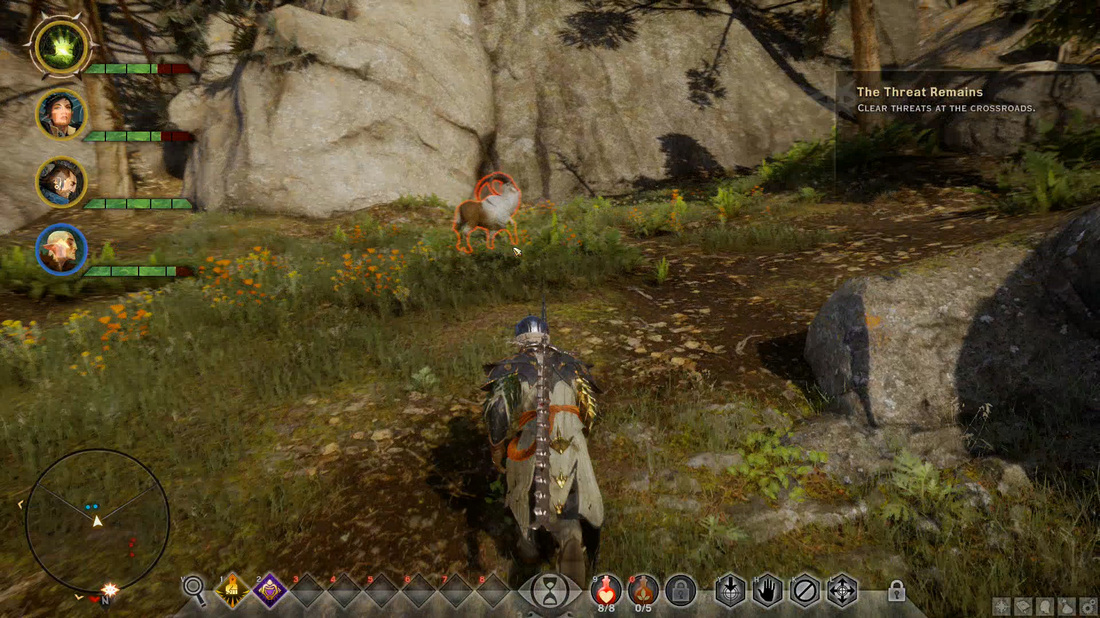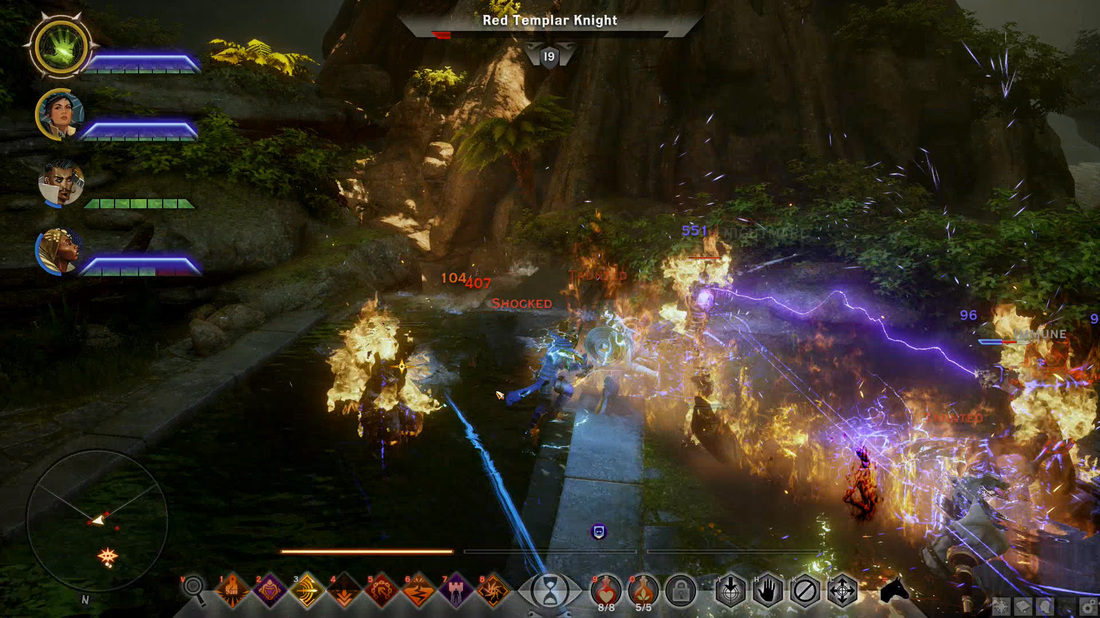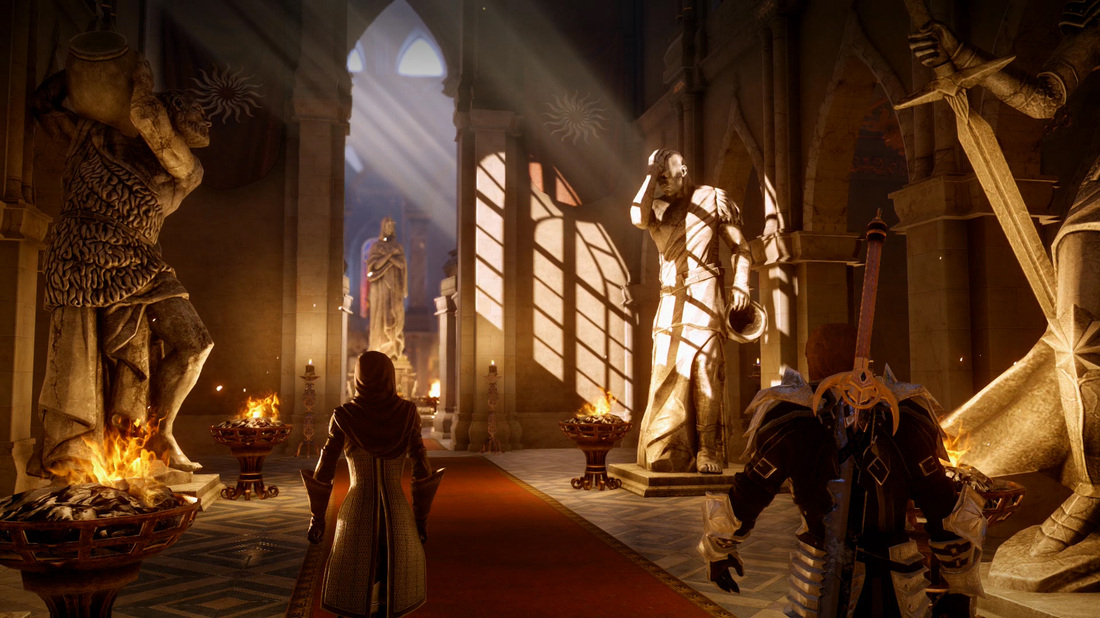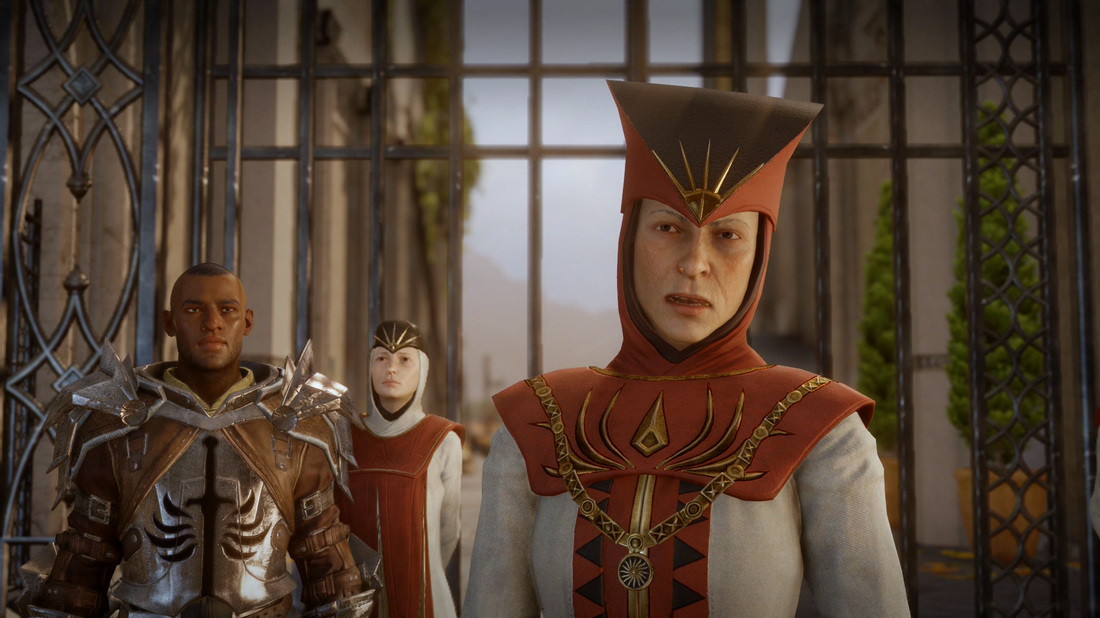 You are the key to it all. You are the key to it all. After an explosion that kills the leadership of the Chantry, one hero emerges from the rubble alive. Now it is up to that person to organize an army, close the rift, and figure out exactly what is going on before a horde of demons pour through the breach and lay siege to humanity.
NOTE (2/8/15): After long debates with key people we decided to lower the recommended age rating for this game from 16 to 14 but keep the minimum age at 14. This was decided mostly because of how the content of this game compared to that of others like it and of previous Dragon Age titles. 1. Gameplay
Bioware, the developers of Dragon Age, have a long history of making great role-playing games, and Dragon Age: Inquisition is one more title they can add to that list. It has a great story, interesting characters, compelling choices, and plenty of content. It’s not completely flawless, but it was well worth my 80+ hour playthrough. It’s an experience that is custom tailored for each player with conversations, characters, and choices that hinge on both the choices in Dragon Age: Inquisition and in the previous Dragon Age games. Some quick words of advice before you start this game. First, make sure you’ve played the other Dragon Age games and their DLCs, otherwise you won’t understand a lot of the minute details. It will also help you gauge whether or not you’ll like this game. If you didn’t like the pacing and the mechanics of Dragon Age: Origins and Dragon Age 2, you’re not going to enjoy this one either. Second, once you’ve started Inquisition, get out of the Hinterlands. Once you get to that point you’ll understand why that’s important, but it’s too easy to get stuck in the timesink that is the game’s first area. Moving out to other areas will keep the game moving at a good pace. The reason why I mention these, especially the thing about the Hinterlands, is that the first 1/4th or so of the game is a bit tedious. The player starts out with few abilities and weak weaponry. My natural inclination is to grind enough so that my character can take on all of my enemies rather easily and then continue with the story, but this meant that I spent 20+ hours doing minor quests, clearing rifts, and just trying to level up without doing any of the more interesting main quests or side quests. It got very dull very quickly and I wasn’t eager to continue that experience. But fortunately that road bump was not the meat of the game. My inane desire to do everything possible in games aside, the main quests and side quests were interesting (and sometimes very funny), the choices felt like they had real weight on the story and its outcome, the villain was well written and his motivations were clear, and each one of the companions had a distinct personality with different quirks and, for the most part, never really felt like a total stereotype. This is a game for someone who wants a long experience. It’s designed for long playthroughs and great replayability. The experience will change depending on what race, class, and gender the player chooses. It’s important to remember that you don’t have to do everything perfectly to beat the final boss. In many situations there is no right answer, there’s just whatever you think is best. This is exactly the kind of game that I wanted.
This game is extremely long. I managed to accomplish many of the main and sidequests (I may have missed a few), all of which took me over 80 hours to complete. While only half of that time was taken up by main and sidequests (the rest of it was spent gathering resources, leveling up, and engaging in conversations), there isn’t much I could have done to significantly reduce the amount of time I played. And there is still plenty more I could do. There were a number of interesting choices that would have led to different missions and conversations, the conversations in the game can change drastically depending on my character’s gender and race, and I could even do the entire game with a different set of choices from Dragon Age: Origins and Dragon Age 2. Even excluding the multiplayer (which is probably for the best), there could easily be 300+ hours of worthwhile gameplay in this game.
There will undoubtedly be things that players will pick up on or miss depending on what class they choose, what console they play on, and how they choose to approach things like combat. I can only speak to what I noticed, but there were a number of things that made this game very frustrating at times. First, and by far most noticeable, was the way that combat worked for the warrior class. My character would frequently have trouble connecting hits to enemies, especially when those enemies were on a lower elevation or were knocked down. This meant that my character would often be swinging his weapon wildly above the downed enemy without doing any damage, making my actions completely useless. There were a number of huge issues like this when it came to melee combat. These issues were not as readily apparent in ranged combat, although there were plenty of times when small changes in elevation or small objects would prevent my ranged characters from connecting attacks to distant enemies. If you’re not a fan of grinding (meaning killing random enemies or doing small, mostly menial / tedious sidequests in order to level up your character), you’ll likely have issues with this game. While I eventually came to enjoy the combat, especially in the epic dragon battles, it took me quite a bit of time to get enough abilities and good enough equipment to feel comfortable going into a new area. This is especially difficult for the first twenty or so hours of the game. 2. Parental Notices
Violence is a prominent element of this game, but the graphicness of the violence will depend on a few key factors (most of which will be negated by the end of the game). Hits from any weapon will result in a small amount of blood from enemies. Warriors, who are often attacking enemies from very short distances, will be able to notice this blood more than ranged characters. If an enemy is killed by a magical attack, a separate animation can sometimes occur that can get slightly more graphic. For example, if an enemy is killed by electricity, the enemy can sometimes disintegrate with a pop into a shower of blood. This type of effect, however, only occurs if the enemy is killed by electricity and is significantly harder to notice towards the end of the game. It is very difficult to see the enemy who is dying when they’re being burned, frozen, shocked, and hit with swords simultaneously. On top of this, the player hardly ever stops to notice the one dying enemy, especially when there are often half-a-dozen other enemies around. Some of the cutscenes also feature violence and blood can be more noticeable in these sections. This is especially noticeable when characters are practicing blood magic, since the cuts will result in a small spurt of blood. However, the violent content in this game is mitigated by the hours upon hours of nonviolent conversations and exploration. I probably ended up spending half of my time in combat and half of it engaging in non-violent activities.
Sexuality is a factor in this game but it seemed less prominent than that in Dragon Age 2. The player never actually sees any sex scenes, although romantic liasons can often fade-to-black (implying sex took place). These scenes often feature female topless nudity. Conversations about sex can also occur, but their contents and frequency will vary drastically depending on the characters involved. Iron Bull and Sera will discuss sex in greater detail and frequency compared to more “conservative” characters like Cassandra and Solas. I didn’t find any example where a character who couldn’t be flirted with or romanced discussed sex. While these discussions are not graphic, they can get a bit racy. For example, there is a conversation the player can have where one character suggests that the main character shaves a crude symbol into her pubic hair as a romantic gesture for Sera. What the symbol is isn’t specified, and the results are never seen. The nudity in the game is only visible if the player pursues a romance. If the player chooses not to pursue a romance (which does not negatively impact the story in any way), the nudity will never be seen. Some of the discussions of sexuality may still occur though.
There are a few notable substances in the game, but the one that the player will use constantly is potions, specifically health potions. Some players will make use of them more than others (I eventually found a way to almost completely eliminate their necessity), but all players will use them. When used, a character will simply procure the potion, down its contents, then throw the glass bottle away. However, it is very easy to miss the animation completely, especially if the player is in combat and/or controlling other characters. There are other potions the player can use, such as lyrium potions to restore magic power, but I found many of these potions only useful for very specific situations. For example, if my mages were low on magic power but I needed them to cast a barrier to protect my characters, I would have them use a lyrium potion first. There are a number of scenes where the main character (and others) will be seen drinking with other characters. This is most notable in one scene where the main character can drink with Iron Bull. The drink of choice is very strong, but after the conversation is done the main character is not affected.
There is one scene where all of the main characters will play a game of cards together. Gambling is involved, and one of the characters ends up losing most of his clothes because of some very poor betting choices. This was the only example of gambling that I noticed. 3. Other Factors
While there are no official modding tools available for this game, there are a few mods available. The vast majority of the mods I found only update very cosmetic aspects of certain characters or visual effects to make the game more visually appealing. None of these resulted in any increased mature content.
Much of the game’s story revolves around the idea that the main character is the Herald of Andraste. Basically, the Herald is a prophet sent by Andraste (bride of the Maker) to do her work. Naturally, that pisses a few people off, specifically the leaders of the Chantry (imagine the Catholic Church, but even more enigmatic). The player can choose to approach the events of the game claiming to be the Herald of Andraste, deny being the Herald, or remain skeptical. The chosen method of approaching the heraldry changes conversations and results over the course of the game. Regardless of how the player approaches being the Herald of Andraste, the player will have an opportunity to select the next head of the Chantry. Like many of the more conversation-driven sideplots, it can be easily missed, but once initiated it is discussed often by a few of the more important characters. This is essentially like the player gets to choose the next Pope, except in this case the Pope is a woman. As far as I can tell, the player cannot have himself / herself elected Chantry Pope regardless of gender. Being a prophet will have to suffice.
The events involving the rifts have basically completely eliminated any idea of local law enforcement (which was already slim in the small towns and wide open wilderness). Therefore, anti-law is not a factor in this game.
My brief experience with the multiplayer of this game seemed to indicate that the online community was civil, but sometimes unhelpful. Some players focus more on exploration, searching the siderooms for items and money. Others focus more on the primary objective, moving as quickly as possible throughout the map. This led to a problem where, no matter which side you chose, you’d be entering an area without your full team, which usually led to everyone’s death. But I didn’t hear or see any trash talking or bullying. That isn’t to say it doesn’t ever happen (the internet being what it is), but I didn’t see this as being much of an issue.
Extreme sports are not a factor in this game.
The plot and the mechanics of this game would not exist without magic. It is an absolutely pivotal part of everything in this game. The main character has a mark on his hand that allows him to open and close doors to “The Fade” (sort of like Limbo, an in-between world). He will team up with mages, Templars, and a host of other characters who will wield weapons that, regardless of type, often have extra elemental effects. He will fight enemies that have eaten red glowing rocks and turned themselves into horrific demons in order to prevent the apocalypse. There is no way to avoid magic in this game. A few of the characters the player can invite into the Inquisition are mages, and the remaining use magical powers to attack enemies (in addition to normal physical attacks).
Human Disfigurement Aside from the normal typically disfigured enemies (i.e. zombies), there are a number of characters who have been disfigured by their use of “red lyrium”, a drug made from magical rocks. Red lyrium makes these characters much stronger, but also makes them go absolutely insane. It also severely disfigures them. Interrogation In one scene the player finds himself in an enemy dungeon where certain characters are being tortured for information. These scenes are very brief and most of the torture is simply implied, not shown. The player only really gets to hear the questioning. Slavery Slavery is discussed a few times in the game and there is one set of missions where the player can free some would-be slaves from their captors. It isn’t a major theme, but a few of the characters discuss its presence. It seemed that slavery was pretty much outlawed in Ferelden and Orlais (the two countries where the game takes place), but was common in Tevinter (a nearby nation). Execution
Execution rarely comes into play, but there were a few noteworthy scenarios where it did become a factor. The most noticeable of these was when the player is judging a mage. The player has the option to execute the mage himself. While the player doesn’t get to see the beheading (it’s out of view of the camera), the sound effect and the small splash of blood implies what happened.
1 Comment
PATRIOT32756
5/4/2016 08:20:20 pm
Would this be minimum age 12 if the player chooses to avoid romances?
Reply
Leave a Reply. |
Like what we do? Want to see more? Donate to the site using the button below!
Not sure what a term means? Read the definitions!
Not sure what a review section is about? Find out more information!
|
















 RSS Feed
RSS Feed